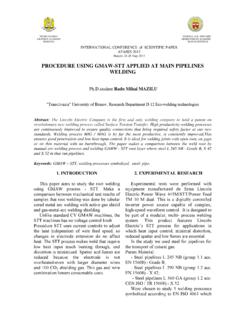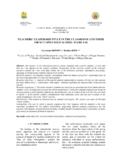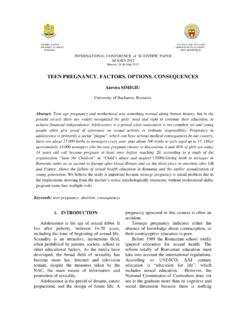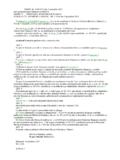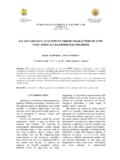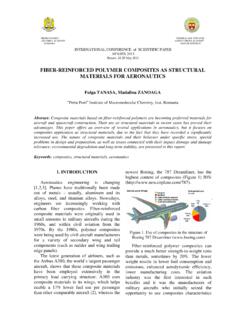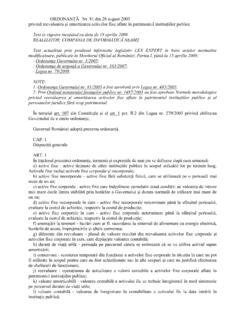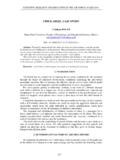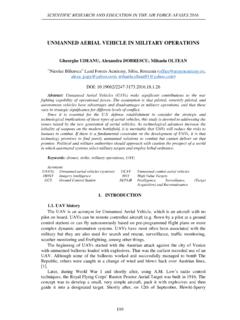Transcription of COMPARISON OF ELECTRIC MOTORS USED FOR …
1 HENRI COANDA GENERAL STEFANIK . AIR FORCE ACADEMY ARMED FORCES ACADEMY. ROMANIA SLOVAK REPUBLIC. INTERNATIONAL CONFERENCE of SCIENTIFIC PAPER. AFASES 2013. Brasov, 23-25 May 2013. COMPARISON OF ELECTRIC MOTORS used FOR ELECTRIC . VEHICLES PROPULSION. Adrian B L ANU, Leonard Marin FLOREA. Faculty of Electrical Engineering, University Politehnica of Bucharest, Romania Abstract: At present, interest in ELECTRIC vehicles road reached a very high level. Undoubtedly, these vehicles will be part of the main means of transport of the future but for them to dominate the market of road vehicles, there is still much research efforts dedicated to this purpose. Also, new industries will be created and will have trained many professionals in the fields of ELECTRIC propulsion systems and components of these systems.
2 Rotary MOTORS are the main components of ELECTRIC propulsion systems of road vehicles (scooters, cars, buses). There are several types of ELECTRIC MOTORS can be used in vehicle propulsion systems: DC MOTORS , synchronous MOTORS with permanent magnets or electromagnetic excitation, switched reluctance synchronous MOTORS , squirrel cage induction MOTORS . Performance of these engines, with performance ELECTRIC batteries or other energy storage mobile units, largely conditions techno-economic performance of ELECTRIC vehicles, which require careful consideration of their choice. In this paper we present a comparative analysis of ELECTRIC MOTORS that are currently used in road vehicle propulsion systems.
3 Keywords: ELECTRIC vehicles, propulsion systems, rotary MOTORS . 1. INTRODUCTION supply, and auxiliary. ELECTRIC propulsion subsystem consists of vehicle controller, ELECTRIC vehicle was converted mainly from electronic power converter, ELECTRIC motor , the existence of an internal combustion vehicle manual transmission and driving wheels. by replacing the internal combustion engine and fuel tank with an ELECTRIC drive motor and a battery unit while retaining all other components as shown in Figure 1. Disadvantages such as heavy load, reduced flexibility, and performance degradation caused ELECTRIC vehicle using this type of use out of. In its place, modern ELECTRIC vehicle is Figure 1.
4 Primary propulsion system of the deliberately built models based on the original ELECTRIC vehicle [8]. frame and body. This unique structure satisfies the requirements of the ELECTRIC vehicle and Power supply subsystem includes: power makes use of a more flexible ELECTRIC supply, power management unit, and unit propulsion. energy recharge. Auxiliary subsystem consists A modern ELECTRIC drive system is of drive power steering, climate control room conceptually illustrated in Figure 2. Drive and auxiliary power unit. propulsion system consists of three major subsystems: propulsion ELECTRIC motor , power fuel cells, ultracapacitor, flywheel, and different hybrid sources. Drive MOTORS for ELECTRIC and hybrid vehicles can be classified into two main groups, namely switching engines and MOTORS without commutation, illustrated in Figure 4.
5 Switching engines are basically traditional DC MOTORS , including excitations series, shunt excitation, excitation compound, separate excitation and excitation permanent magnet MOTORS . DC MOTORS switches and brushes need to enter armature Figure 2. conceptual illustration of the general current, thus making them less reliable and configuration of an ELECTRIC vehicle [2] unfit for maintenance-free operation and high speed. 2. ELECTRIC PROPULSION system . It consists of ELECTRIC MOTORS , power converters, and electronic control (Figure 3). The ELECTRIC motor converts electrical energy into mechanical energy for propulsion of the Figure 4. Classification of motor units for ELECTRIC vehicle or vice versa, to enable regenerative and hybrid vehicle applications [2].
6 Braking or charging energies to generate electrcitate stored on board. Power converter is Recent technological developments have used to power the ELECTRIC motor with the pushed ELECTRIC MOTORS without switching into proper voltage and current. Electronic a new era. Benefits include increased controller can be further subdivided into three efficiency, increased power density and low functional units: sensor interface circuits and operating costs. They are also more reliable processor. and maintenance-free compared with switching, so those without switch became more attractive. Induction MOTORS are widely accepted as a type of engine without switching to ELECTRIC vehicle propulsion.
7 This is due to the low cost, high reliability and maintenance- free operation. However, conventional control of induction motor such as variable voltage, variable frequency can not provide the desired performance. With the advent of power electronics and microchip age, principle as Figure 3. Functional block diagram of a typical field oriented control or vector control of ELECTRIC propulsion system [2] induction motor have been accepted to overcome the complexity of control because of The sensor is used to translate the their nonlinearity. However, these control measured quantities such as voltage, current, methods suffer from low efficiency in light temperature, speed, torque, and flow in load and limited range of operating at constant electrical signals through interface circuits.
8 Power. By replacing the field winding These signals are conditioned to the permanent magnet synchronous motor classic, appropriate level before being introduced into permanent magnet synchronous MOTORS can the processor. Processor output signals are remove conventional brushes, slip rings, and usually amplified through interface circuits act field copper losses (Figure 5). In fact, the of power semiconductor devices power permanent magnet synchronous MOTORS are converter. Energy source refers to batteries, HENRI COANDA GENERAL STEFANIK . AIR FORCE ACADEMY ARMED FORCES ACADEMY. ROMANIA SLOVAK REPUBLIC. INTERNATIONAL CONFERENCE of SCIENTIFIC PAPER. AFASES 2013. Brasov, 23-25 May 2013.
9 Also known as brushless MOTORS with brushless MOTORS powered sinusoidal due to permanent magnet or permanent magnet sinusoidal AC and brushless configuration and cost. Choice of ELECTRIC propulsion (BLDC). Variable reluctance synchronous systems for ELECTRIC vehicles depends MOTORS (SRM) were recognized to have great primarily on three factors: expectations driver, potential for applications in ELECTRIC and hybrid vehicle constraints, and energy source. Among vehicles (Figure 6). the various types of ELECTRIC motor drives, different types are considered viable powertrain electrification, namely those with DC motor , induction motor (induction motor ), wound rotor synchronous motor , switched reluctance motor and motor brushless permanent magnet (Figure 7).
10 Figure 5. Relative ranking based on maximum torque at the same volume [1]. Figure 7. Overall COMPARISON of different types of MOTORS for traction propulsion system [8]. Given the above table, topology selection ELECTRIC machines for traction vehicles was restricted inside and concentration flux permanent magnet synchronous MOTORS with radial flow but also axial flux machines with permanent magnets. Permanent magnet machines are becoming more common in traction applications due to high power density, compactness and current availability of power electronics needed for effective control. Figure 6. COMPARISON based on cutting torque Despite recent increases in the price of permanent ripples at the same volume [1] magnets, they are still profitable.
